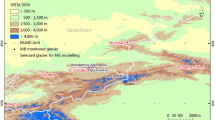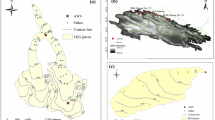Abstract
On the basis of the data of glacier mass balance during 1946–2005 over Svalbard, Northern Scandinavia, and Southern Norway, the characteristics of glacier mass-balance are analyzed, and its sensitivity to climate change is calculated using a simple degree-day model. The mass balance of glaciers in these three regions reached maximum or comparatively high values in the late 1980s or the early 1990s. After that there was an accelerating negative tendency. A glacier with more positive mass balance has a higher sensitivity to equilibrium-line altitude (or climate) change and vice versa. On average, the mass loss during the entire period in these three regions was equivalent to the result of an air temperature rise of 0.32°C relative to zero net balance state. The highest temperature increase is found in Svalbard, and is 0.55°C; however, a rise of only 0.12°C is found in Southern Norway. The net balance sensitivity to a hypothetical air temperature increase of +1°C ranges from −0.31 to −1.03 m w.e. a−1, and the net balance sensitivity to an assumed increase in snow precipitation of +10% varies from +0.05 to +0.37 m w.e. a−1; thus, a 31% increase in snow precipitation is needed to compensate for the net mass loss induced by an air temperature increase of +1°C. The summer balance sensitivity to a hypothetical air temperature increase of +1°C varies from −0.39 to −0.95 m w.e. a−1, and the winter balance sensitivity to an assumed increase in snow precipitation of +10% ranges from +0.02 to +0.38 m w.e. a−1. This study confirms early findings that maritime glaciers have comparatively higher mass balance sensitivity than continental glaciers.





Similar content being viewed by others
References
Arendt AA, Echelmeyer KA, Harrison WD, Lingle CS, Valentine VB (2002) Rapid wastage of Alaska glaciers and their contribution to rising sea level. Science 297(5580):382–386
Braithwaite RJ (1995) Positive degree-day factor for ablation on the Greenland ice sheet studied by energy-balance modelling. J Glaciol 41(137):153–160
Braithwaite RJ (2005) Mass-balance characteristics of arctic glaciers. Ann Glaciol 42:225–229
Braithwaite RJ, Raper SCB (2007) Glaciological conditions in seven contrasting regions estimated with the degree-day model. Ann Glaciol 46:297–302
Braithwaite RJ, Raper SCB (2009) Estimating equilibrium-linealtitude (ELA) from glacier inventory data. Ann Glaciol 50(53):127–132
Braithwaite RJ, Zhang Y (1999) Modelling changes in glacier mass-balance that may occur as a result of climate changes. Geogr Ann 81A(4):489–496
Braithwaite RJ, Zhang Y (2000) Sensitivity of mass-balance of five glaciers to temperature changes assessed by tuning a degree-day model. J Glaciol 46(152):7–14
Braithwaite RJ, Zhang Y, Raper SCB (2003) Temperature sensitivity of the mass balance of mountain glaciers and ice caps as a climatological characteristic. Zeitschaift Für Gletscherkunde Und Glazialgeologie 38(1):35–61
De Woul M, Hock R (2005) Static mass-balance sensitivity of arctic glaciers and ice caps using a degree day approach. Ann Glaciol 42:217–224
Ding Y, Liu S, Zhou W, Bing H (1996) Variations of glacier mass-balance and their climatic implication. Adv Earth Sci 11(6):590–596 (in Chinese)
Dowdeswell JA, Hagen JO, Björnsson H, Glazovsky AF, Harrison WD, Holmlund P, Jania J, Koerner RM, Lefauconnier B, Ommanney CSL, Thomas RH (1997) The mass-balance of Circum-Arctic glaciers and recent climate change. Quat Res 48:1–14
Dyurgerov MB (2002) Glacier mass-balance and regime: data of measurements and analysis[C]. Meier MF, Armstrong R (eds) Occasional Paper, Vol. 55[C]. CO: Institute of Arctic and Alpine Research, University of Colorado, Boulder
Dyurgerov MB, Meier MF (1999) Analysis of winter and summer glacier mass-balance [J]. Geogr Ann 81(A):541–554
Dyurgerov MB, Meier MF (2005) Glaciers and the changing earth system: A 2004 snapshot[R]. Institute of Arctic and Alpine Research, University of Colorado, Boulder
Fleming KM, Dowdeswell JA, Oerlemans J (1997) Modelling the mass-balance of Northwest Spitsbergen glaciers and responses to climate change. Ann Glaciol 24:203–210
Gorczynski W (1920) Sur le calcul du degré de continentalisme et son application dans la climatologie. Geogr Ann, pp 324–331
Hagen JO, Liestøl O (1990) Long term glacier mass-balance investigations in Svalbard, 1950–1988. Ann Glaciol 14:102–106
Hock R (2003) Temperature index melt modeling in mountain areas. J Hydrol 282:104–111
Holmlund P, Jansson P, Pettersson R (2005) A re-analysis of the 58 year mass-balance record of Storglaciären, Sweden. Ann Glaciol 42:389–394
Jaedicke C, Gauer P (2005) The influence of drifting snow on the location of glaciers on western Spitsbergen, Svalbard. Ann Glaciol 42:237–242
Letréguilly A, Reynaud L (1990) Space and time distributions of glacier mass-balance in the northern hemisphere. Arctic Alpine Res 22(1):43–50
Meier MF, Dyurgerov MB, Rick UK, O’Neel S, Tad Pfeffer W, Anderson RS, Anderson SP, Glazovsky AF (2007) Glaciers dominate eustatic sea-level rise in the 21st Century. Science 317(1064):1064–1067
Oerlemans J, Fortuin JPF (1992) Sensitivity of glaciers and small ice caps to greenhouse warming. Science 258:115–117
Ohmura A, Kasser P, Funk M (1992) Climate at the equilibrium line of glacier. J Glaciol 38(130):397–411
Paterson WSB (1994) The physics of glaciers, 3rd edn. Pergamon, Oxfird, p 480
Schneeberger C, Blatter H, Abe-Ouchi A, Wild M (2003) Modelling changes in the mass-balance of glaciers of the northern hemisphere for a transient 2 × CO2 scenario. J Hydrol 282:145–163
Schuler TV, Hock R, Jackson M, Elvehøy H, Braun M, Brown I, Hagen JO (2005) Distributed mass-balance and climate sensitivity modeling of Engabreen, Norway. Ann Glaciol 42:395–401
Serreze MC, Francis JA (2006) The Arctic on the fast track of change. Weather 61(3):65–69
Shahdgedanova M, Popovnin V, Aleynikov A, Petrakov D, Stokes CR (2007) Long-term change, interannual and intra-seasonal variability in climate and glacier mass-balance in the central Greater Caucasus, Russia. Ann Glaciol 46:355–361
Solomon S, Qin DH, Manning M (2007) Climate change 2007: The physical science basis. Contribution of working group I to the fourth assessment report of the intergovernmental panel on climate change [M]. Cambridge University Press, Cambridge
Stuefer M, Rott H, Skvarca P (2007) Glaciar Perito Moreno, Patagonia: climate sensitivities and glacier characteristics preceding the 2003/04 and 2005/06 damming events. J Glaciol 53(180):3–16
Szafraniec J (2002) Influence of positive degree–days and sunshine duration on the surface ablation of Hansbreen, Spitsbergen glacier. Pol Polar Res 23(2–3):227–240
Thomas V Lowell (2000) As climate changes, so do glaciers. Natl Acad Sci Proc (PNAS) 97(4):1351–1354
Xu M, Yan M, Kang J, Ren J (2007) Progress in studies on mass-balance of glaciers, Svalbard, Arctic. J Glaciol Geocryol 29(5):730–737 (in Chinese)
Yan Z (1992) A primary analysis of the process of the 1960 s Northern hemispheric summer climatic jump. Scientia Atmospherica Sinica 16(1):111–119 (in Chinese)
Zhang Y, Liu S (2006) Progress of the application of degree-day model to study glaciers and snow cover. J Glaciol Geocryol 28(1):101–107 (in Chinese)
Zhang Y, Liu S, Ding Y (2006) Spatial variation of degree-day factors on the observed glaciers in Western China. Acta Geographical Sica 16(1):89–98 (in Chinese)
Acknowledgments
This study was supported by the National Natural Science Foundation of China (No. 40876098) and the State Oceanic Administration, China (No.10/11YR01). The authors are very grateful to the Norwegian Meteorological Institute for providing meteorological data, and Prof. Braithwaite R J and an anonymous reviewer for valuable comments which helped to improve the manuscript.
Author information
Authors and Affiliations
Corresponding author
Rights and permissions
About this article
Cite this article
Xu, M., Yan, M., Kang, J. et al. Comparative studies of glacier mass balance and their climatic implications in Svalbard, Northern Scandinavia, and Southern Norway. Environ Earth Sci 67, 1407–1414 (2012). https://doi.org/10.1007/s12665-012-1585-3
Received:
Accepted:
Published:
Issue Date:
DOI: https://doi.org/10.1007/s12665-012-1585-3




